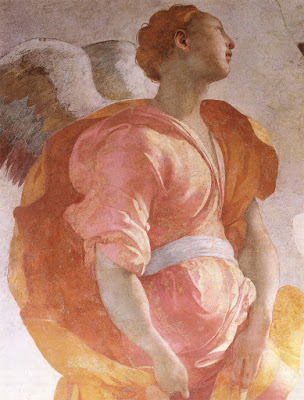 |
| Pontormo Annunciatory Angel (Capponi Annunciation) ca. 1526-28 fresco Chiesa di Santa Felicità, Florence |
 |
| Pontormo Virgin Annunciate (Capponi Annunciation) ca. 1526-28 fresco Chiesa di Santa Felicità, Florence |
 |
| Pontormo Virgin and Child with Five Saints ca. 1529 oil on panel Musée du Louvre |
 |
| Pontormo The Visitation 1528-29 drawing (compositional study) Gabinetto dei Disegni, Galleria degli Uffizi, Florence |
 |
| Pontormo The Visitation 1528-29 oil on panel Pieve di San Michele Arcangelo, Carmignano |
 |
| Pontormo The Visitation ca. 1514-16 fresco Basilica della Santissima Annunziata, Florence |
 |
| Pontormo Supper at Emmaus 1525 oil on canvas Galleria degli Uffizi, Florence |
 |
| Pontormo Portrait of a Halberdier ca. 1530-40 drawing (figure study) Gabinetto dei Disegni, Galleria degli Uffizi, Florence |
 |
| Pontormo Portrait of a Halberdier ca. 1530-40 oil on canvas Getty Museum, Los Angeles |
 |
| Pontormo Portrait of a Youth ca. 1525 oil on canvas Palazzo Mansi, Lucca |
 |
| Pontormo Portrait of Monsignor della Casa ca. 1541-44 oil on panel National Gallery of Art, Washington DC |
 |
| Pontormo Joseph in Egypt Episodes with Jacob 1515-18 oil on panel National Gallery, London |
 |
| Pontormo Joseph in Egypt Episodes with Jacob (detail) 1515-18 oil on panel National Gallery, London |
 |
| Pontormo Joseph in Egypt Punishment of the Baker 1515-18 oil on panel National Gallery, London |
 |
| Pontormo Joseph in Egypt Joseph's Brothers beg for Help 1515-18 oil on panel National Gallery, London |
"The great protagonist of the first Florentine Maniera lived into the time of full fruition of the high Maniera (he died on 1 January 1557), and in this time his contribution signified both participation in the newer style and dissent from it. Pontormo shared in the development of those aspects of the high Maniera of which his own inventions were a precedent, but did not yield the basic tenet that distinguished his attitude towards art from it. We have earlier defined the core of Pontormo's difference from the high Maniera, too summarily, as the fusion that he makes between form and an expressive value that is not just in the form but in the complex human psyche and in the matter the form illustrates. As his descendants of the high Maniera made more quantitative ornamental value out of form, so in these later years did Jacopo, but his ornament remained a value with a different content in it of emotive poignance. His art became almost as elaborate as theirs, as arbitrary in its pattern-making and in the canons of behavior that he assumed for his actors. His manner was more arbitrary in the liberties that he now, as earlier, took with nature: the high Maniera, after all, was an aesthetic that had to do with a specialized conception of propriety, in which there were 'correct' limits of representational licence, as much as of emotional response, which should not be trespassed. Pontormo's individuality, which had created a vocabulary of Maniera as an agency for personal expression, was not disposed to accept the restrictions that the new generation had invented for it. He remained, throughout the years of Bronzino's and Vasari's rise, the most formidable figure on the Florentine scene, but a disquieting one, more worrisome – and at times antipathetic – to his Maniera colleagues of the second generation, than he had been earlier to the classical establishment."
– S.J. Freedberg, Painting in Italy 1500-1600 in the Pelican History of Art series (1970)